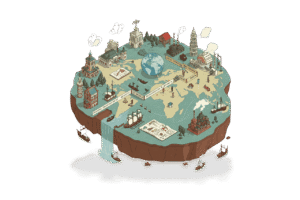1.1: States in Africa, Afro-Eurasia, East Asia, Europe, South and Southeast Asia, and the Americas
1.2: Global and regional religions and belief systems
2.1: The Silk Roads
2.2: The Mongol Empire
2.3: The Indian Ocean trading network
2.4: The trans-Saharan trade routes
2.5: The effects of cross-cultural interactions
3.1: The development of the Manchu, Mughal, Ottoman, and Safavid empires
3.2: How rulers of empires maintained their power
3.3: Religious developments in empires
4.1: The influence of scientific learning and technological innovation
4.2: The Columbian Exchange
4.3: Development and expansion of maritime empires
4.4: Internal and external challenges to state power
4.5: Changes to social hierarchies linked to the spread of empires
5.1: The Enlightenment
5.2: Revolutions against existing governments and the birth of new nation-states
5.3: The Industrial Revolution
5.4: Trade policies
5.5: The development of industrial economies
6.1: State expansion in the 18th and 19th centuries
6.2: Resistance to imperialism
6.3: The growth of the global economy
6.4: Economic imperialism
6.5: Causes and effects of new migration patterns
7.1: Changes in the global political order after 1900
7.2: World War I: its causes and how it was fought
7.3: The interwar period
7.4: World War II: its causes and how it was fought
7.5: Mass atrocities after 1900
8.1: The causes and effects of the Cold War
8.2: The spread of communism
8.3: How colonies in Asia and Africa achieved independence
8.4: The creation of new states after decolonization
8.5: The end of the Cold War
9.1: Advances in technology and their effects
9.2: Disease
9.3: Environment
9.4: Economic change
9.5: Movements for reform
9.6: How globalization changed culture
9.7: New international institutions

Giáo viên theo sát, điều chỉnh linh hoạt để đạt hiệu quả cao nhất
Đặt mục tiêu điểm số & định hướng rõ ràng
Xây dựng kế hoạch học tập chi tiết, khoa học
Giáo viên theo sát, điều chỉnh linh hoạt để đạt hiệu quả cao nhất
Xác định điểm mạnh, yếu & nhu cầu

Đặt mục tiêu điểm số & định hướng rõ ràng

Xây dựng kế hoạch học tập chi tiết, khoa học

Giáo viên theo sát, điều chỉnh linh hoạt để đạt hiệu quả cao nhất

Teaches:
Curriculum:

Teaches:
Curriculum:

Teaches:
Curriculum:

Teaches:
Curriculum:

Teaches:
Curriculum:

Teaches:
Curriculum:

Teaches:
Curriculum:

Teaches:
Curriculum:
| Điều Kiện / Tính Năng | Standard | Premium | Platinum |
|---|---|---|---|
| 🌟Cam kết điểm số theo mục tiêu | ❌ | ❌ | ✅ |
| Bài tập và Ghi chú bài giảng | ✅ | ✅ | ✅ |
| Bài tập tại lớp và Đáp án | ✅ | ✅ | ✅ |
| Bài tập về nhà bổ sung | ✅ | ✅ | ✅ |
| Đề thi mẫu và Đề thi các năm | ✅ | ✅ | ✅ |
| Ngân hàng câu hỏi/Đề thi | ✅ | ✅ | ✅ |
| Hỗ trợ bài tập về nhà vào sáng thứ 7 | ❌ | ✅ | ✅ |
| Cố định giáo viên | ❌ | ✅ | ✅ |
| Hỗ trợ các bài IA, EE, TOK | ❌ | ✅ | ✅ |
| Phản hồi tin nhắn sau giờ hành chính (phản hồi đến 21:30) | ❌ | ✅ | ✅ |
| Buổi gặp gỡ đầu tiên của Giáo viên & Học sinh | ✅ | ✅ | ✅ |
| Buổi trao đổi của Giáo viên & Phụ huynh | ❌ | ✅ | ✅ |
| Báo cáo học tập định kỳ | ✅ | ✅ | ✅ |
| Đánh giá và nhận xét của giáo viên sau mỗi buổi học | ✅ | ✅ | ✅ |
| Chính sách thay đổi lịch học (báo trước trong giờ hành chính) | 24 tiếng | 12 tiếng | 06 tiếng |
| Cam kết đậu kỳ thi | ✅ | ✅ | ✅ |
Đừng ngần ngại liên hệ Intertu


Liên hệ ngay